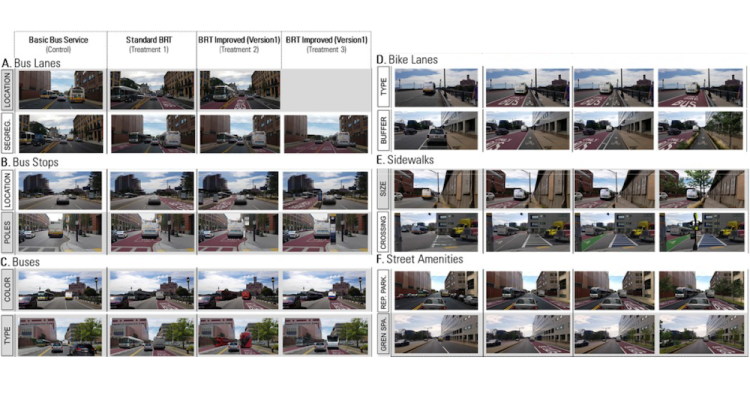Enhancing Public Participation in Public Transit Infrastructure

Example of Photographic Simulations of Different BRT Infrastructure Options
Bus rapid transit (BRT) is a bus-based mobility system that seeks to increase capacity, reliability, and safety of buses as a transit choice. Unlike light rail systems, BRT’s infrastructural and operational costs are much lower and the system as a whole is more plastic, able to adapt to changes in the environment and ridership preferences, making BRT an attractive option for urban planners seeking to introduce better public transit options. Despite these alluring traits, BRT projects have often faced community opposition, particularly focused on how they alter other modes of mobility’s access to transit infrastructure. But how do the changes associated with various BRT projects impact individuals' perception of their safety and their subjective well being?
In a paper published in Transportation Research, Pablo Navarrete-Hernandez and Chris Zegras utilize a Boston urban corridor to explore how 65 different BRT infrastructure alternatives impact perceived well-being, safety, usability, and happiness.
“Expert-centered methods of promoting best practice design guidelines for BRT infrastructure to address community concerns, draw little from evidence of BRT infrastructure’s impacts on communities’ subjective well-being,” write Navarrete-Hernandez and Zegras. “In part, this is due to a lack of methodological strategies to identify, from a wide range of infrastructure options, evidence-based designs that enhance the subjective well-being of the communities impacted by a project and its potential alternatives. A better understanding of the impact of such alternatives may help to build stakeholder support, and allow for the realization of more and higher-quality BRT projects.”
Using randomized control trials with photo-simulations of BRT infrastructure alternatives to collect data from 1,470 respondents, Navarrete-Hernandez and Zegras highlight a new approach to enhance participatory planning processes and design more effective infrastructure options.
Navarrete-Hernandez is a lecturer in landscape planning at the Department of Landscape Architecture at University of Sheffield and a co-founder of the experimental big-data analysis platform urban-experiment.com. His research investigates the relationship between the built environment, human behavior and emotions to promote sustainable, healthy and inclusive futures for cities.
Zegras is Professor of Mobility and Urban Planning and the current Department Head of DUSP. His research spans interrelated areas critical to tackling metropolitan mobility challenges: human behavior, digital transformation, and strategic planning techniques and technologies. He has consulted widely for a diverse range of governments, inter-governmental organizations, and nongovernmental organizations.
Read their full paper, “Mind the perception gap: The impact of bus rapid transit infrastructure on travelers’ perceptions of affective subjective well-being”


